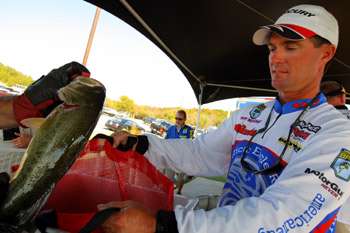
The last Central Open of the season on Lake Texoma was a study in shallow water bassing. Some targeted rock, some wood, and at least one threw at anything he could find so long as his water was less than five feet deep. No matter their target, however, each of the four top finishers caught 15 bass over three days to earn their checks.Here's how they did it.
1st place:
Terry Butcher
(46 pounds, 8 ounces)
Terry Butcher, an Elite Series angler who hails from Talala, Okla., targeted only largemouths on his march to a wire to wire victory in the last Open of the season.
"I was fishing up in the Washita Arm all five days of my practice. I figured I'd need largemouth weight to win this one," said Butcher after the event. "That part of the lake is full of big, thick brushpiles. I wanted to target them later in the day when my early morning bite started to slow down."The early morning bite to which he refers was triggered by cranking a Bomber 4A with a Foxy Shad finish across a shallow rockpile located alongside a drop. Most of his bass struck immediately after his bait careened off the rock.As the sun climbed higher he targeted deeper brushpiles — 8-10 feet — in the same general area. His approach to the brush was twofold. First, he fished the edges of the wood with a chartreuse blue sparkle Bomber Fat Free Shad Jr. Later, he worked the tangled insides with plastic.
"My crankbait was used to located brush and then to catch the bass holding on the outside edges of it. Once I'd fished those areas I changed to a 10-inch plum candy Yum Ribbontail Worm."That bait really was my ace in the hole. It produced my biggest bass. I fished it real slow, basically just letting it soak in the middle of the brushpile. There were times I'd let it sit perfectly still for three or four minutes. And I frequently fished one pile of brush for 20-30 minutes.
"Slow was the deal. If you moved it fast or bounced it around, the fish were invisible. You had to put it in front of them and then wait them out, knowing that they were there, and knowing that they would bite. There was no pushing them. It was their way or the highway."Butcher fished his Bomber 4A with an American Eagle XE700 series rod, a Bass Pro Shops Pro Qualifier reel (6.3:1 gear ratio) and 12-pound-test Silver Thread fluorocarbon line. His Fat Free Shad Jr. was thrown with the same reel on an American Eagle XE701C rod and 14-pound-test Silver Thread fluorocarbon line.
For his plastics he chose an American Eagle prototype flipping stick, the same Bass Pro Shops Pro Qualifier reel and 17-pound-test line. His hook was a standard off-set, wide gap worm hook. He used a heavy worm weight to keep his worm on the bottom.
2nd place:
Bradley Hallman
(34 pounds, 10 ounces)
Norman, Okla., Elite Series pro Bradley Hallman tossed a 3/8-ounce handmade brown jig with a green pumpkin plastic trailer on his way to a second place finish."I flipped and pitched my bait to everything I could find sticking out of the water. Sometimes it was a dock, sometimes a stickup, sometimes a fence. Heck, I'd have thrown to a refrigerator if I could have found one."Every fish I caught was in shallow water, less than 4 feet deep. They ate it as soon as it hit the water or they didn't eat it at all. I moved very quickly from one target to another. That let me cover up to 40 spots in the course of the day."He tossed his jig with a 7-foot, medium heavy Fenwick Techna AV rod and an Abu Garcia Revo reel (6.4:1 gear ratio) spooled with 15-pound-test Berkley Trilene 100% Fluorocarbon line.
One thing I do want to emphasize (that has nothing to do with my pattern) is the importance of never giving up in a tournament setting. On the last day I had one fish at 2:55 p.m. and needed to be at the no wake buoy by 3:20. In less than 15 minutes I caught four more keepers that let me move up 12 places. Never forget that the last cast is as good as the first cast."
"I was able to bang it around rocks between one and five feet deep without experiencing a lot of time consuming hang-ups. The trick for me was to hit the rock as hard as possible and then hang on. Almost all my bass hit immediately after my bait bounced off the rock. It was instant."Burns fished with an 8-foot Falcon Lowrider Outtasight medium weight rod, a Team Daiwa Fuego reel (6.3:1) and 10-pound-test P-line Fluorocarbon line.
"On the few occasions that the jig didn't work, I'd throw a Strike King Pro Model 4S crankbait with a Sexy Shad finish. It helped wake up a few sleepers, I think. All of my bass were really shallow. I never caught a bass deeper than three feet during the tournament."Basically, I ran a long milk run. I burned 20 or more gallons of gas every day. There were times I ran a mile or more just to fish one isolated piece of structure or cover. It was tough, but well worth it in the end."
Clark worked his jig with a 7 foot Waterloo heavy action flipping stick, a Pflueger high speed reel (7:1 gear ratio) and 25-pound-test Seaguar Carbon Pro line. His crankbait tackle was identical except that he switched to 15-pound-test Seaguar invizX line.
